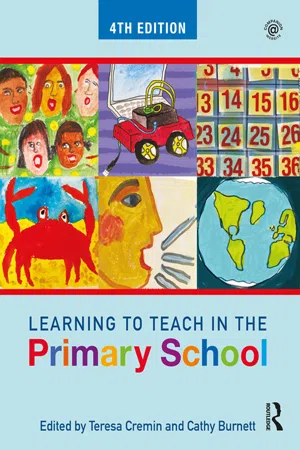
Learning to Teach in the Primary School
- 576 pages
- English
- ePUB (mobile friendly)
- Available on iOS & Android
Learning to Teach in the Primary School
About this book
How do you become an effective primary school teacher? What do you need to be able to do? What do you need to know?
Flexible, effective and creative primary school teachers require subject knowledge, an understanding of their pupils and how they learn, a range of strategies for managing behaviour and organising environments for learning, and the ability to respond to dynamic classroom situations.
The fourth edition of this bestselling textbook has been fully updated with the latest research and initiatives in the field, as well as the most recent changes to the National Curriculum across the UK. Twenty four new authors have contributed, sharing their expertise and experience as practitioners. Ten brand new units have been included on:
- Becoming a professional in the current context
- Building inclusive communities of engaged learners
- Understanding schools' aims and enacting your own
- Teaching for social justice
- Reading
- Grammar and punctuation
- Mastery in mathematics
- The value of outdoor learning
- Primary education in a digital age
A selection of extra tasks have been woven throughout, with an emphasis on innovative, reflective practice, and new 'vivid examples' bring each chapter's argument to life in a classroom context. In addition, each chapter contains M-level tasks and further reading to assist with research assignments, and differences in the National Curriculum and policy in Scotland, Wales and Northern Ireland are highlighted.
Providing a comprehensive but accessible introduction to teaching and learning in the primary school, covering everything a trainee needs to know in order to gain QTS, this accessible and engaging textbook is essential reading for all students training to be primary school teachers.
This textbook is supported by a free companion website with additional resources for instructors and students (www.routledge.com/cw/Cremin) and an accompanying series of books on Teaching Creatively across the curriculum.
Frequently asked questions
- Essential is ideal for learners and professionals who enjoy exploring a wide range of subjects. Access the Essential Library with 800,000+ trusted titles and best-sellers across business, personal growth, and the humanities. Includes unlimited reading time and Standard Read Aloud voice.
- Complete: Perfect for advanced learners and researchers needing full, unrestricted access. Unlock 1.4M+ books across hundreds of subjects, including academic and specialized titles. The Complete Plan also includes advanced features like Premium Read Aloud and Research Assistant.
Please note we cannot support devices running on iOS 13 and Android 7 or earlier. Learn more about using the app.
Information
SECTION 1
BECOMING A TEACHER
UNIT 1.1
PRIMARY TEACHING
INTRODUCTION
- form a view of the nature of primary teaching;
- develop an awareness of the personal qualities and skills you require as a primary teacher;
- form views as to the purposes of primary teaching;
- be overawed, yet excited, at the responsibility of being a primary school teacher.
‘ACROSTIC’ TEACHING

A SENSE OF STYLE
TEACHING: SCIENCE, CRAFT OR ART?

Table of contents
- Cover
- Half Title
- Series Page
- Title Page
- Copyright Page
- Contents
- List of figures
- List of tables
- List of tasks
- List of contributors
- Introduction
- Section 1 Becoming a Teacher
- Section 2 Exploring the Nature of Learning and Teaching
- Section 3 Planning and Managing Learning
- Section 4 Approaches to the Curriculum
- Section 5 Assessment
- Section 6 Diversity and Inclusion
- Section 7 Recent Developments
- Section 8 Partnership in Practice
- Section 9 Your Professional Development
- Index